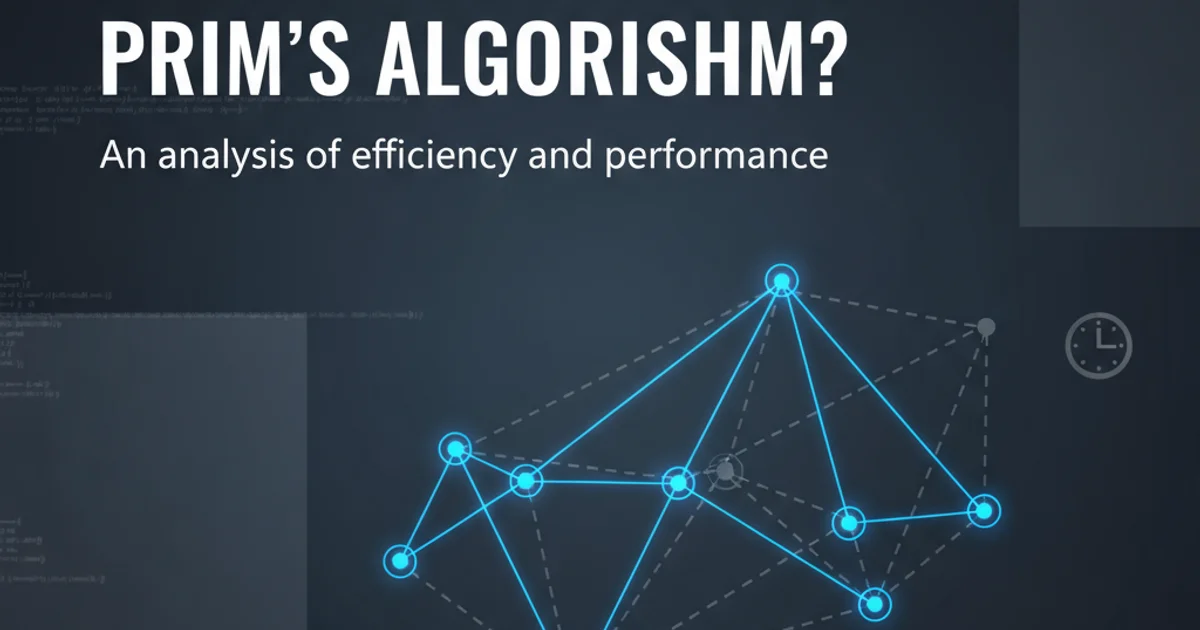Time Complexity of Prims Algorithm?
Categories:
Understanding the Time Complexity of Prim's Algorithm

Explore the efficiency of Prim's algorithm for finding Minimum Spanning Trees, analyzing its time complexity with different data structures.
Prim's algorithm is a greedy algorithm used to find a Minimum Spanning Tree (MST) for a weighted undirected graph. An MST is a subset of the edges of a connected, edge-weighted undirected graph that connects all the vertices together, without any cycles and with the minimum possible total edge weight. Understanding its time complexity is crucial for selecting the right algorithm for graph problems, especially with large datasets.
How Prim's Algorithm Works
Prim's algorithm starts with an arbitrary vertex and grows the MST one edge at a time. At each step, it adds the cheapest edge that connects a vertex in the MST to a vertex outside the MST, ensuring no cycles are formed. This process continues until all vertices are included in the MST. The efficiency of this selection process heavily depends on the data structures used to manage the edges and vertices.
flowchart TD
A[Start with an arbitrary vertex] --> B{Are all vertices included?}
B -- No --> C[Find the cheapest edge connecting MST to non-MST vertex]
C --> D[Add edge and its non-MST vertex to MST]
D --> B
B -- Yes --> E[MST Found]Flowchart illustrating the steps of Prim's Algorithm
Analyzing Time Complexity with Different Implementations
The time complexity of Prim's algorithm varies significantly based on the data structures used to implement the priority queue (min-heap) that stores the candidate edges. The core operations are extracting the minimum-weight edge and decreasing the key of an edge (updating its weight if a cheaper path is found).
Let V be the number of vertices and E be the number of edges in the graph.
1. Adjacency Matrix and Array/Min-Heap
When the graph is represented using an adjacency matrix, and a simple array or a binary min-heap is used for the priority queue, the complexity changes. An adjacency matrix allows O(1) access to edge weights between any two vertices. However, finding the minimum edge to add to the MST requires iterating through all vertices not yet in the MST.
Implementation Details:
- Graph Representation: Adjacency Matrix (O(V^2) space)
- Priority Queue: An array to store the minimum edge weight to connect each vertex to the MST, or a binary min-heap.
Time Complexity Breakdown:
- Initialization: O(V) to set all distances to infinity.
- Main Loop: Runs V times (once for each vertex).
- Extract Min: If using an array, finding the minimum takes O(V) time. If using a binary min-heap, it takes O(log V).
- Update Keys (Edges): For each vertex added to the MST, we iterate through all its adjacent vertices. In an adjacency matrix, this means checking V potential edges. Updating the key (distance) for each neighbor takes O(1) for an array or O(log V) for a binary min-heap.
Overall Complexity:
- With Array: O(V * (V + V)) = O(V^2)
- With Binary Min-Heap: O(V * (log V + V log V)) = O(V^2 log V) (less efficient than array for dense graphs due to heap operations on V elements).
2. Adjacency List and Binary Min-Heap
This is a common and efficient implementation, especially for sparse graphs. The adjacency list stores only existing edges, and a binary min-heap efficiently manages candidate edges.
Implementation Details:
- Graph Representation: Adjacency List (O(V + E) space)
- Priority Queue: Binary Min-Heap to store (weight, vertex) pairs.
Time Complexity Breakdown:
- Initialization: O(V) to set distances.
- Main Loop: Runs V times.
- Extract Min: O(log E) or O(log V) if heap stores vertices. Since E can be up to V^2, log E is generally preferred. If the heap stores at most V elements (the minimum edge to each non-MST vertex), it's O(log V).
- Update Keys (Edges): When a vertex is extracted, we iterate through its adjacent edges. For each neighbor, we might perform a
decrease-keyoperation on the heap. In the worst case, each edge (E edges total) might be inserted into the heap once and potentially updated once. Adecrease-keyoperation on a binary min-heap takes O(log E) or O(log V).
Overall Complexity:
- O(E log V): Each edge is processed at most twice (once from each endpoint), leading to at most E
decrease-keyoperations. Eachdecrease-keytakes O(log V) time (if the heap size is at most V). The Vextract-minoperations take O(log V) each. So, V log V + E log V = O(E log V).
3. Adjacency List and Fibonacci Heap
For very dense graphs, a Fibonacci heap can offer a theoretical improvement, though its practical implementation is complex and often slower due to higher constant factors.
Implementation Details:
- Graph Representation: Adjacency List (O(V + E) space)
- Priority Queue: Fibonacci Heap.
Time Complexity Breakdown:
- Initialization: O(V).
- Main Loop: Runs V times.
- Extract Min: O(log V) amortized time.
- Update Keys (Edges): Each edge is processed at most twice. A
decrease-keyoperation on a Fibonacci heap takes O(1) amortized time.
Overall Complexity:
- O(E + V log V): V
extract-minoperations take O(V log V) amortized. Edecrease-keyoperations take O(E) amortized. Thus, the total is O(E + V log V).
import heapq
def prim(graph):
min_spanning_tree = []
start_node = list(graph.keys())[0]
visited = {start_node}
edges = []
# Add all edges from the start_node to the priority queue
for neighbor, weight in graph[start_node]:
heapq.heappush(edges, (weight, start_node, neighbor))
while edges and len(visited) < len(graph):
weight, u, v = heapq.heappop(edges)
if v in visited:
continue
visited.add(v)
min_spanning_tree.append((u, v, weight))
for neighbor, edge_weight in graph[v]:
if neighbor not in visited:
heapq.heappush(edges, (edge_weight, v, neighbor))
return min_spanning_tree
# Example Usage:
# graph = {
# 'A': [('B', 2), ('C', 3)],
# 'B': [('A', 2), ('C', 1), ('D', 1)],
# 'C': [('A', 3), ('B', 1), ('D', 4)],
# 'D': [('B', 1), ('C', 4)]
# }
# mst = prim(graph)
# print(mst)
Python implementation of Prim's algorithm using a binary min-heap.